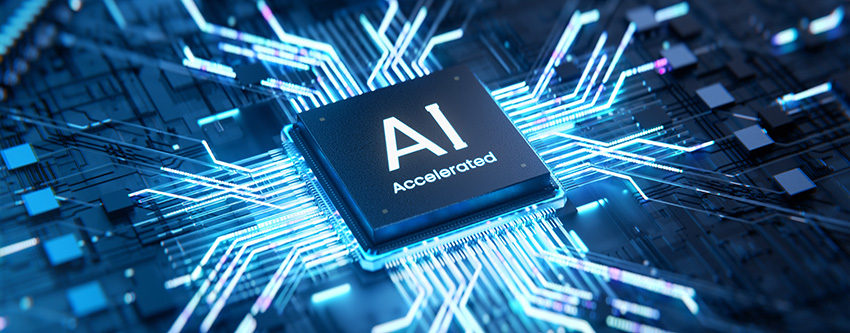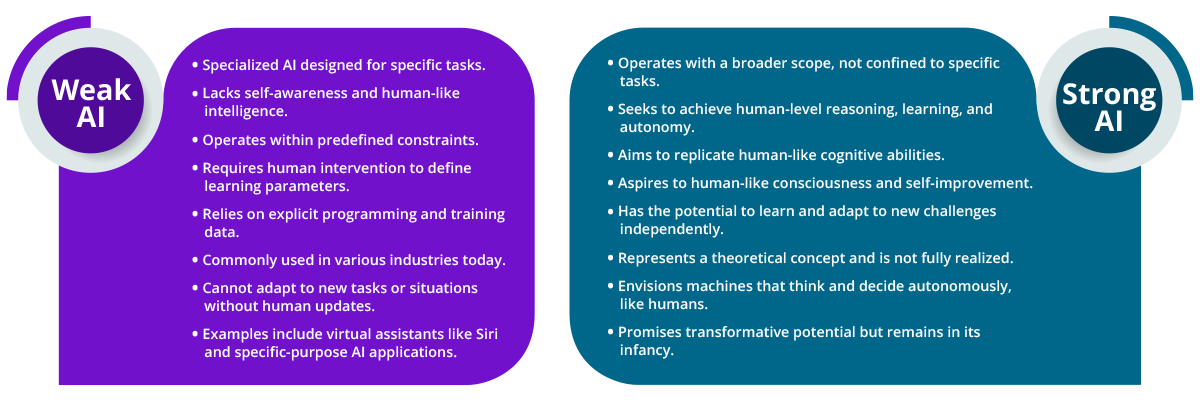
Defining intelligence in the realm of Artificial Intelligence (AI) is a task that grows more intricate as technology advances. Is intelligence winning a game of chess? interpreting languages? deciphering human emotions? or crafting creative fiction? As AI evolves, the definition of intelligence becomes increasingly complex. Current AI systems, often referred to as Weak or Narrow AI, have not yet achieved human-like cognition. The elusive concept of Strong AI, capable of learning and thinking akin to humans without human programming, seems to linger just beyond the horizon. In this exploration, we delve into the distinctions between these two dimensions of AI.
Understanding Weak AI
Weak AI, often referred to as specialized AI or narrow AI, represents artificial intelligence with constrained capabilities. These systems employ advanced algorithms to address specific problem-solving or reasoning tasks, but they operate within a limited scope, far from encompassing the full spectrum of human cognitive abilities. For instance, voice-based virtual assistants like Siri and Alexa fall under the category of Weak AI, as they function within pre-defined task boundaries, often yielding predetermined responses. Weak AI underscores the idea that machines can replicate and apply intelligent behavior to tackle complex problems, although their intelligence remains task-focused rather than holistic.
Unlike Strong AI, which aspires to mimic the full range of human cognition, Weak AI is designed for particular tasks and lacks self-awareness or human-like intellect. While it may exhibit human-level reasoning to some extent, it remains restricted in its capabilities. Nevertheless, Weak AI excels in performing specific tasks with speed and precision, outperforming humans in many scenarios. Its applications span diverse domains, including fraud detection, financial planning, transportation, image enhancement, medicine, and scientific research. Industries such as robotics, entertainment streaming, and email services leverage Weak AI for object recognition, recommendation systems, and spam detection. However, it's important to note that Weak AI cannot autonomously acquire new skills, necessitating human oversight for adaptation to evolving circumstances, for example: changes in traffic laws for self-driving cars.
Weak AI comprises two key AI types: reactive machines, capable of immediate responses but lacking memory and learning capacity, and limited memory machines, which can store knowledge and utilize it for learning and training in subsequent tasks. This narrow focus has propelled significant technological advancements in recent years.

Strong AI: The Quest for True Artificial Intelligence
Strong AI, often referred to as Artificial General Intelligence (AGI), envisions machines that possess consciousness on par with humans, equipped with the cognitive prowess to think and act independently, without human intervention. These systems rely on intricate algorithms, enabling autonomous decision-making akin to human judgment. Strong AI seeks to create machines that function autonomously, much like humans, asserting that a computer with the right organization can possess human-like cognitive attributes. This is the AI depicted in sci-fi classics like "Her," "The Terminator," and "I-Robot."
In the realm of AI development, Strong AI, or AGI, represents the theoretical pursuit of endowing machines with intelligence equivalent to humans, marked by self-aware consciousness enabling problem-solving, learning, and future planning. Its ultimate goal is to create intelligent machines indistinguishable from the human mind. However, akin to human cognitive development, such AI entities would commence as novices, requiring input and experiences to refine and augment their capabilities continually.
While AGI remains primarily a theoretical concept, the realization of Strong AI remains elusive, with perspectives on its feasibility varying widely. The distinction between Weak and Strong AI depends on the ability to learn and adapt to unexpected challenges. While AI, like ‘MuZero’, demonstrates goal pursuit without explicit human instruction, the question of whether AI can genuinely perceive and process emotions akin to humans remains a topic of philosophical and futuristic speculation. As Strong AI approaches, it holds transformative potential in domains like security, healthcare, and robotics. However, it also raises ethical concerns related to the development of AI with potentially harmful intentions.
The difference Between Strong AI and Weak AI
Strong AI and Weak AI represent distinct facets of artificial intelligence, each with its unique characteristics and potential. Strong AI embodies the notion of machines that can reason, learn, and perform tasks akin to humans, while Weak AI excels at specific functions, such as answering questions or playing chess. Weak AI, operates under more defined constraints and relies on human input to define learning parameters and provide training data for accuracy. In contrast, Strong AI aspires to human-like consciousness and autonomy, capable of self-improvement and adaptation.
While Weak AI is prevalent in today's technology landscape, powering applications like virtual assistants and self-driving cars, it specializes in specific tasks and falls short of human-like cognition. In contrast, Strong AI is theoretical, with the potential to revolutionize industries once fully realized. Despite this, Weak AI has already made significant strides across various domains, setting the stage for AI's evolution towards more human-like intelligence.
The demarcation between Weak AI and Strong AI continues to evolve as technology advances. While Strong AI holds transformative potential, it remains in its infancy, leaving room for ethical considerations and uncertainty about its emergence. The distinction between these AI categories will likely blur further as AI research progresses, ultimately reshaping our understanding of artificial intelligence.

Charting the AI Journey: From Weak to Strong and Beyond
In the ever-evolving landscape of artificial intelligence, the distinction between Weak AI and the elusive Strong AI marks a crucial juncture in our technological journey. While Weak AI continues to shape our daily lives, enhancing efficiency and transforming various facets of existence, Strong AI is promising a future where machines may mirror human cognition and autonomy. Beyond that lies the realm of Super AI, a concept that sparks both curiosity and concern, envisioning machines that surpass human intelligence across disciplines. However, we must remember that Super AI remains speculative, and the path to it is uncertain.
As we venture into this uncharted territory, it is essential to tread cautiously, with safeguards in place to ensure that the future of AI aligns with our collective values and aspirations, rather than the dire scenarios portrayed in fiction. Ultimately, the journey from Weak AI to Strong AI, and perhaps even Super AI, will be a testament to our ingenuity and responsibility in harnessing the potential of artificial intelligence for the betterment of humanity.